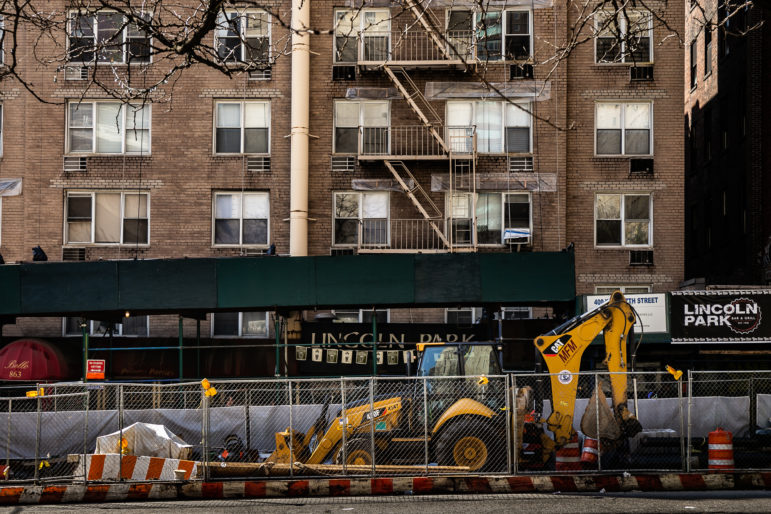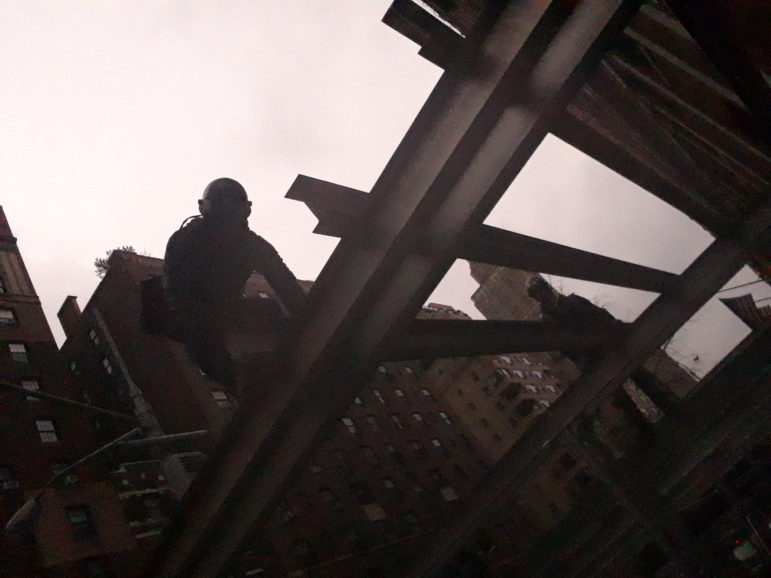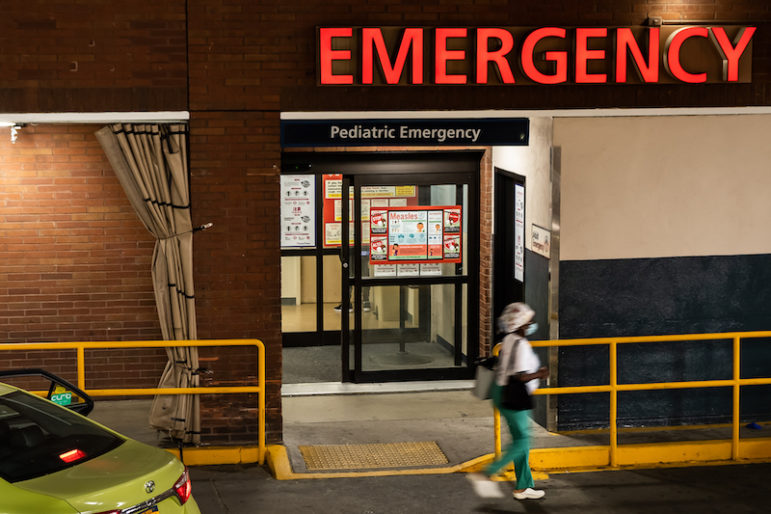
Adi Talwar
Lincoln Park, a bar on 9th Avenue, is one of hundreds of city businesses operating under sidewalk sheds.
Though it’s been almost 40 years since Lori E. Gold last saw her sister Grace, she has cherished memories of the girl who in 1979 started attending her alma mater, Columbia University.
“That year we started to get close, so it was a huge opportunity. She probably would have been my best friend today,” the consultant, who now lives in Florida, says. “There wasn’t anyone who met her who wasn’t affected by her many talents and beauty.”
Lori had graduated from Columbia University the year before and was working in Washington D.C. when, on a Wednesday night, she got an urgent call from her uncle in the city, insisting she return home immediately. He wouldn’t say why.
Her late father was on his way home from Long Island when he heard on the car radio of a student killed by falling masonry early that evening. He later told Gold that, as he listened, he had contemplated the odds that his younger daughter was the student. “He thought ‘One in 2,000.’ Then when the radio said a Barnard student, my father thought, ‘One in 500,'” she says. “When the radio said a 17-year-old had been hit, he popped a nitroglycerine tablet. He could do the math.” Her cousins said they had never seen him cry before. When Gold herself got home, she found a police officer, a rabbi—and her uncle who revealed the “great shock” to her.
That May 16th was a warm one, with temperatures reaching 77 degrees. Lori still has a photograph of Grace smiling in her summer dress as she poses with two graduating friends in their gowns before heading post-ceremony with others to celebrate. “This was the big day,” Lori recalls fondly. “I understand that she and a bunch of friends were walking to the Citi cash machine further south and didn’t quite make it.”
Along the crowded sidewalk on 115th street and Broadway the group of friends were moving when a one-foot slab of ornamental terra cotta broke free from the lintel of a 1912 apartment house, seven stories above. As a detective told a Times reporter, the slab “bounced off the sill and dropped to the sidewalk,” striking Grace Gold in the forehead, killing her.

The Gold family
Grace Gold
In response to the tragedy, the following year the New York City Council passed Local Law 10, requiring owners to do façade inspections periodically on buildings over six stories, later amended to Local Law 11 in 1998 to include all facades, and now called the Facade Inspection Support Program. The same law also requires the owner of a building to install sidewalk sheds to protect pedestrians.
But nearly 40 years on, with more than 14,000 buildings participating in the program, not everyone is happy with the proliferation of hunter-green sidewalk sheds the law has helped generate. The owners say the wooden barriers drive customers away in droves and turn their storefronts into makeshift homeless shelters.
Up for months or years, business owners want the shedding outside their bars, bodegas, and jewelry stores removed at a much faster rate than is currently the norm in many neighborhoods, and are backing a controversial proposal that is making its way through the City Council amid stiff resistance from powerful industry groups.
A barrier to business with no end in sight
A new, interactive Department of Buildings (DOB) map reveals a metropolis threaded with “sidewalk bridges” as they are also called, especially Manhattan.
In interviews on scaffold-shaded streets all over the city, City Limits found that not all merchants were disapproving of scaffolding. Some didn’t see a difference in foot traffic or declined to comment because the manager wasn’t around. But for dozens of merchants, the mere mention of sidewalk sheds stirred discord, mixed with varying degrees of anger. Whether you sell jewels on Madison Avenue or run a sports bar on the West Side, sell pizza in Midtown or cut hair in Sunnyside, the word is that under the sidewalk shed sales slump.
Srinivas Vasireddy, who with his wife has owned the Hero Hut Deli on Flushing Avenue in Woodside for six years, says “It was the rezoning,” that brought the apartment complex slowly climbing to completion next door—apparently referring to the 2006 Maspeth/Woodside rezoning.
“It used to be that you could build three stories. Now it’s 10,” he says, making all the difference for his storefront’s future. Anything smaller and the city would have required only five feet of his storefront to be covered. However, for construction over 100 feet, a bridge must be extended 20 feet on either side of the property line, virtually burying his business, he says.
“It looks like it’s closed,” Srinivas says, expressing a common sentiment citywide about customers who walk by assuming the business is a construction site: They can’t see. At unwanted expense, he hired a lawyer, who sent a letter requesting that the developer unblock his signage, but he got no reply. “If it’s for public safety, I understand,” he says, bemoaning the 30 percent drop in sales since construction began. “The thing is, they are keeping it for a long time.” The heavy planks and hunter-green parapet have been up since September 2016.
Srinivas’s wife worries their store will go the same way as the shuttered Colombian cafe on the other side of the side of the site, which folded months after the shedding was installed.
“If you can see, my customers are all regulars. It’s rare I see new customers,” she says.
Louis, a clerk at Foot Locker on Union Square, watched the installment of another shed on a recent Wednesday afternoon, seemingly vexed the parapet was partially concealing his storefront signage. An inspector on the scene projected a protracted timeline when asked when it was coming down. “It can stay up there for 10, 20 or 50 years,” he says as he rummages through a blue haversack on his back. “I’ve seen sidewalk sheds stay up for years.” The owner must simply renew the permit and properly maintain everything.
“We have seen foot traffic fall by between 20 and 40 percent,” Louis said.
A block away at Euro Concept, a high-end kitchen showroom, a sidewalk shed outside for façade repair is taking tens of thousands of dollars from his pocket only after six months, owner Steven Kazantzis tells City Limits.
“Our business is different than a restaurant. If you lose a customer you can lose $20,000 or $100,000,” he says, suggesting that a shed does not need to be up for years to bite into one’s bottom line.
Not all the concerns are in Manhattan, or at properties with ground-floor retail. At a six-story coop at 2025 Valentine Avenue in the Bronx, a neighbor of 35 years says, “Once in a blue moon” when asked if she has ever seen work on the façade, even though city records show the sidewalk shed has been there since 2011. A seven-year timeline doesn’t make sense for repairs on a building for that size, she says.
At her own building, she says, it took three weeks to fix the facade before workers took down the sidewalk shed even though her apartment building is significantly larger. Records for the current worksite show tens of thousands in fines and 11 open violations with the Environmental Control Board, most for violations of Local Law 11.
“It’s dangerous for children,” she says of the shed, whose last work permit posted on the front door expired in 2016.
Proposed remedy stirs controversy
Mayor de Blasio has in the past agreed that sidewalk sheds are a quality of life issue, bringing grime and crime – at least to NYCHA developments. “For too long, government ignored the needs of NYCHA residents,” the mayor told a crowd in 2015 at a NYCHA development in Sheepshead Bay, where he announced news that more than eight miles of shedding had been removed from NYCHA developments because active construction was not taking place. “These unnecessary sidewalk sheds at developments across the city were a vivid, constant reminder of this neglect,” the mayor told the crowd.
The mayor’s move still left around 280 miles of shedding in the city as of 2017—or 7,700 sheds, a staggering number Councilmember Ben Kallos wants to drastically cut.
The Democrat represents Council District 5 covering the Upper East Side, Midtown East, Roosevelt Island and East Harlem and wants all construction equipment—not just the sheds or “scaffold” as he calls them—removed within a six-month framework with exceptions for complications like seasonal issues. If Intro 1389, which he first introduced in 2016, is passed there will no longer be the green spectacle “in perpetuity” he tells City Limits: If the developer stops work, the city will step in and take the scaffold down.
A quirk in the existing Local Law 11 allows the sidewalk sheds to stay up without coming down. Property owners are legally obligated to maintain their properties in a “safe” condition. An unscrupulous landlord who doesn’t want to repair the facade will merely leave the shed up without doing repairs, thus catching any falling debris and following the letter of the law. The owner might choose this path even if it brings financial penalties because that option could still be the most cost effective.
Kallos says he sees the impact of the law’s flaws. Across the street from his Council office, shedding has been in place for eight years despite a lack of work.
“Every day I see scaffolds where work is not happening at existing buildings,” he says.
Industry professionals tell City Limits privately that such delays could occur for legitimate and unavoidable reasons, such as a dysfunctional co-op board, delays in receiving city permits, new owners, a broke landlord who inherited an old walk-up, a building exchanging hands. Imposing a six-month limit, one architect warned, was “arbitrary” and could create a risk to public safety. And some wonder why a landlord would needlessly allow a shed to stay up if it was hurting their commercial tenants, who pay him rent.
The Real Estate Board of New York (REBNY) says Kallos’ proposed law will inconvenience the developer and the public and bring further delays. “The bill is well-intentioned but there are too many unintended consequences,” insists REBNY’s Carl Hum, senior vice president of the organization, which represents more than 13,000 building owners and professionals.
Kallos’s office tells City Limits that the bill was reintroduced in 2017 and that negotiations are continuing with the DOB, REBNY and the Rent Stabilization Association (RSA), a trade group for residential building owners, which did not comment for this story. “We have to negotiate with other people in the room,” Kallos says.
Kevin Dougan, director of the New York State Restaurant Group, supports the bill, as does the New York Hospitality Alliance. Dougan says that more than 600 of his members (mostly in Manhattan) report seeing a 40-percent slump in earnings because of the sheds, in an industry where profits are low as is.
In a 2016 sweep, the DOB says it found that 98 percent of the sheds are necessary to protect the public, ordering the remainder to be removed. But that’s a number whose accuracy Dougan doubts, given the lack of inspectors. Kallos says the sweep did not determine whether work was active at each site.
On the other side of town, Noel Donovan, co-owner of Blooms Tavern near midtown, is waiting for a city inspector to turn up and approve the dismantling of the building owner’s shed. DOB say they must be removed “immediately” once construction is complete. So why, the Irishman asks, is he waiting a year and counting with no inspector in sight despite outreach efforts by the local midtown BID?
“It’s really killing our tourism business. They can’t see us,” Noel Donovan says. “If you’re a tourist visiting a foreign city you don’t want to walk down a block with construction in it. You want to walk down a sexy block.”
Not far from Village Cigars in the West Village sheds sit on every other street for blocks. “For months, years its been staying there. It’s not good for me. That much I can tell you,” the counter clerk, Ahmed Nehad, says. “They’re not working, just staying there for months and months,” he says. Pedestrians just pass by. The shed is turned into a makeshift homeless shelter in the evening.
“It’s a shelter for them to congregate as soon as the stuff goes up,” says David Killen, who owns a gallery nearby on West 25th. Blocks away at P.C. Richards & Son, manager Richard Rodriquez jokes from behind scaffolding: “We’re hiding. We’re hiding,” he tells City Limits. “There’s nothing we can do.”

Gerard Flynn
Setting up scaffolding.
“Scaffolding is big business, very big business,” says Randy, an experienced rigger with Spring Scaffolding, who was recently setting up a sidewalk shed on the Upper East Side for his firm, one of the biggest in the business. Randy says he has seen horrific scaffolding accidents in his time, including one worker who fell to the sidewalk where his helmet fell off, exposing brain matter.
A rigger at a scaffolding firm who asked not to be named says installing scaffolding remains a safety hazard though not like it was around 20 years ago when a lack of safety nets made the job “very dangerous.” On top of that, if the work is not done right, the DOB will come around and shut the job down. He regales with stories of the worker who fell eight stories and lived and speaks with deep respect for the famous men of the scaffold. “They are great men, great men,” he insists, stepping down from his stool. “They work very hard. Scaffolding is hard work. Everything is heavy. Everything is heavy, especially the bridge work. They earn their money,” he says.
Critics of Kallos’s bill say building owners could have to pay a huge reinstallment fee if work pauses and scaffolding must come down, then go back up. Firm data on the size of the scaffolding industry or its cost structure is hard to come by, but anecdotal reports indicate it’s no cheaper than it is pretty.
“The union package is about $90 an hour,” the rigger says. “That’s with annuity and pension and all that. That’s what it costs for one carpenter.” He says union workers cost twice as much as non-union counterparts. Fifty feet of scaffolding can cost $20,000 installment fees–which pays for insurance, an engineer and union carpenters.
As for Lori Gold, she says her sister’s death “defined building safety bringing in local law.” She doesn’t recall near as many sidewalk sheds in the city before the tragic events of May 1979 but adds that many pedestrians are alive today because of them.
Still, she acknowledges, they should not be a “bandaid” over the issue of public safety. The city needs to force landlords to make necessary repairs and take them down. “I don’t think they should be out there forever. Who does?”








2 thoughts on “Bid to Change City’s Scaffolding Law Stirs Old Debate”
Looks like I am in the wrong business. Scaffolding is where the money is.
Marine Equities/ Meridian Properties has two buildings which have not been pointed in more than 16 years. 101 Lincoln Road had a keystone fall from the 6th floor 2 years ago. and now 115 lincoln road has had it’s shed blown down by strong winds. the shed hit a tenant in the head which required in hospital visit. the scaffolding at 115 Lincoln Road has been up for more than a decade with no work being done. these are perfect examples of the loop holes in local law 11. scaffolding instead of pointing !